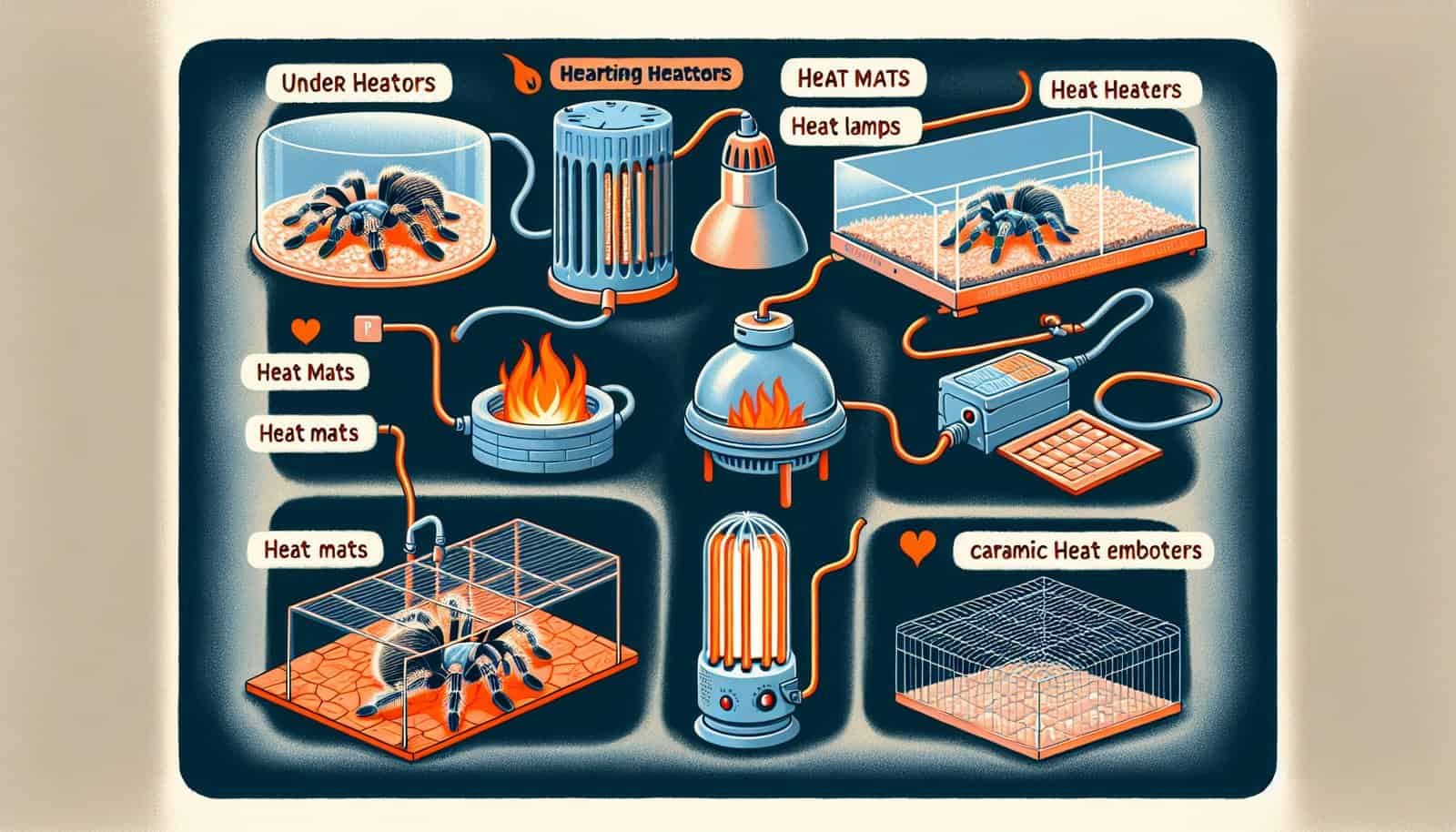If you’ve recently become the proud owner of a tarantula and are looking to create the perfect habitat for your eight-legged friend, one crucial aspect to consider is the type of heating source that will keep them comfortable. While tarantulas are renowned for their ability to adapt to a variety of environments, it’s still important to provide them with the right level of warmth. In this article, we will explore some of the heating options available and help you choose the most suitable one for your tarantula’s enclosure. So, let’s dive into the world of tarantula care and discover the best heating sources for these fascinating creatures.
Infrared Ceramic Heat Emitters
Advantages
One heating source that is suitable for tarantula enclosures is the Infrared Ceramic Heat Emitters. These emitters produce heat by emitting infrared radiation, which directly warms the objects and surfaces in the enclosure. Here are some advantages of using Infrared Ceramic Heat Emitters:
-
Efficient Heating: Infrared Ceramic Heat Emitters can efficiently heat the tarantula enclosure by providing a consistent and gentle heat source. They are capable of producing a steady heat that mimics the natural warmth tarantulas experience in their native habitats.
-
Non-Disruptive Lighting: Unlike other heat sources, Infrared Ceramic Heat Emitters do not emit light that can disrupt the tarantulas’ natural day-night cycle. This ensures that the enclosure remains dark and allows the tarantulas to maintain their nocturnal behavior without disturbance.
-
Safe Heating Option: Infrared Ceramic Heat Emitters are a safe option as they do not emit any visible light and do not pose a risk of burns or fire hazards. They can be used with a thermostat to regulate the temperature, ensuring the enclosure doesn’t get too hot for the tarantulas.
Disadvantages
While Infrared Ceramic Heat Emitters offer several advantages, there are also some potential disadvantages to consider:
-
Dry Heat: Infrared Ceramic Heat Emitters tend to produce dry heat, which can lead to low humidity levels in the tarantula enclosure. This can be problematic for tarantulas that require higher humidity levels to thrive. Additional humidity may need to be provided using alternative methods, such as misting or adding a water dish.
-
Expensive Initial Cost: Compared to other heating sources, Infrared Ceramic Heat Emitters can be more expensive to purchase initially. However, they are generally energy-efficient and have a longer lifespan, which can make them cost-effective in the long run.
-
Limited Heat Direction: Infrared Ceramic Heat Emitters emit heat in all directions, which may require careful positioning to ensure an optimal heat gradient is created within the enclosure. This can be more challenging in larger enclosures or setups with multiple hiding spots for the tarantulas.
Overall, Infrared Ceramic Heat Emitters are a suitable heating source for tarantula enclosures due to their efficient and safe heating capabilities. However, considerations should be made to maintain appropriate humidity levels and ensure proper heat distribution within the enclosure.
Under Tank Heaters (UTH)
Advantages
Another heating source option for tarantula enclosures is Under Tank Heaters (UTH). UTHs are heating pads or mats that are placed underneath the enclosure to provide a localized heat source. Here are some advantages of using Under Tank Heaters:
-
Uniform Heat Distribution: Under Tank Heaters provide a consistent heat source across the surface area of the enclosure. This allows tarantulas to thermoregulate by moving closer to or further away from the heat as needed.
-
Easy Installation: UTHs are relatively easy to install and require minimal setup. They usually come with an adhesive side that sticks to the bottom of the enclosure securely. This simplicity makes them a popular choice among tarantula keepers.
-
High Efficiency: Under Tank Heaters are known for their energy efficiency as they primarily heat the substrate, which then radiates warmth upwards. This ensures that the tarantulas receive heat from the ground up, replicating their natural environment where they often burrow into the warm ground.
Disadvantages
Despite their advantages, Under Tank Heaters also have some potential disadvantages:
-
Limited Heating Area: Under Tank Heaters provide a localized heat source, which means that the warmth may not be evenly distributed throughout the entire enclosure. Tarantulas may have to move to specific areas to access the desired temperature, which can limit their range of thermal options.
-
Risk of Overheating: It is essential to monitor the temperature closely when using Under Tank Heaters, as they can potentially cause overheating if not regulated properly. A thermostat should be used to maintain the desired temperature range and prevent the substrate from becoming too hot for the tarantulas.
-
Potential for Burns: Direct contact with the heating pad or mat can cause burns to the tarantulas if they come into direct contact with it. To mitigate this risk, it is recommended to use a layer of substrate or a heat-resistant barrier between the heating pad and the enclosure floor.
Considering the advantages and disadvantages, Under Tank Heaters can be a viable heating source for tarantula enclosures, especially for terrestrial species that prefer ground-level warmth. However, careful temperature monitoring and appropriate substrate choices are essential to ensure the safety and well-being of the tarantulas.

Heat Mats
Advantages
Heat Mats, also known as heat pads or heat tape, are another popular heating source option for tarantula enclosures. These mats are typically placed underneath or on the side of the enclosure to provide localized warmth. Here are some advantages of using Heat Mats:
-
Focused Heating: Heat Mats offer focused heating in specific areas of the enclosure, allowing tarantulas to choose their preferred temperature gradient. This is especially beneficial for arboreal species that may prefer to thermoregulate by climbing closer or further away from the heat source.
-
Energy Efficiency: Heat Mats are designed to create heat uniformly and efficiently. They are commonly low-wattage devices, ensuring they consume minimal electricity while effectively maintaining the desired temperature range within the enclosure.
-
Safe for Burrowing Tarantulas: Burrowing tarantula species benefit from Heat Mats as they mimic the warmth found in the lower levels of the ground. The heat radiates from the bottom, allowing tarantulas to burrow into the substrate closer to the heat source, replicating their natural behavior.
Disadvantages
Despite their advantages, there are also some potential disadvantages to consider when using Heat Mats:
-
Limited Heat Distribution: Heat Mats offer localized heat, which may result in temperature variations within the enclosure. Careful positioning and monitoring of the heat mats are necessary to ensure a suitable temperature gradient is maintained to accommodate the needs of the tarantulas.
-
Risk of Overheating: Due to their focused heating nature, there is a risk of overheating if the temperature is not properly regulated. Using a thermostat is crucial to prevent the heat mats from reaching extreme temperatures that can harm the tarantulas.
-
Heat Mat Lifespan: Heat Mats may have a limited lifespan compared to other heating sources due to wear and tear over time. Regular inspection and replacement of damaged or worn-out heat mats are essential to ensure the continued effectiveness and safety of the heating system.
In conclusion, Heat Mats are a viable heating source option for tarantula enclosures, particularly for species that prefer localized warmth or have burrowing tendencies. However, careful monitoring and temperature regulation are crucial to prevent overheating and provide a suitable temperature gradient for the tarantulas’ well-being.
Heat Lamps
Advantages
Heat Lamps are a commonly used heating source for tarantula enclosures, providing both heat and light. The lamps typically use incandescent bulbs or ceramic heat emitters to generate warmth. Here are some advantages of using Heat Lamps:
-
Dual Functionality: Heat Lamps offer both heat and light, which can be beneficial for tarantulas that require a higher light intensity or have specific temperature and lighting needs. It provides a more natural day-night cycle and allows for easier observation of the tarantulas’ behavior.
-
Wide Heat Distribution: Depending on the wattage and positioning of the heat lamp, it can provide a more extensive heat distribution throughout the enclosure. This can be advantageous for larger enclosures or setups with multiple hiding spots, ensuring the entire enclosure remains within the desired temperature range.
-
Adjustable Temperature: Heat lamps can be used with a thermostat or dimmer switch to regulate the temperature more precisely. This allows for fine-tuning of the heat output and ensures that the enclosure maintains a consistent and suitable temperature for the tarantulas.
Disadvantages
Despite their advantages, there are also some potential disadvantages to consider when using Heat Lamps:
-
Visible Light: Heat Lamps emit visible light along with the heat, which may disrupt the tarantulas’ natural day-night cycle. For species that are primarily nocturnal, excess light can cause stress and affect their behavior.
-
Potential for Burns: Heat Lamps, particularly those using incandescent bulbs, can become extremely hot. If placed too close to the enclosure or not properly shielded, they pose a risk of burns to the tarantulas if they come into direct contact with the lamp or the heated surroundings.
-
Energy Consumption: Heat Lamps can consume more energy compared to other heating sources, especially if used to provide both heat and light. This can lead to higher electricity costs over time, particularly for larger or multiple tarantula enclosures.
In summary, Heat Lamps are a versatile heating source that provides both heat and light, catering to the needs of tarantulas requiring specific lighting conditions. However, considerations should be made to minimize visible light, prevent the risk of burns, and account for potential energy consumption when using Heat Lamps as the primary heating source.

Heat Cable
Advantages
Heat Cable, also known as heat tape, is a specialized heating source that consists of a flexible cable with built-in heating elements. It can be installed along the sides or bottom of the tarantula enclosure to provide even heat distribution. Here are some advantages of using Heat Cable:
-
Uniform Heating: Heat Cable offers uniform heat distribution along its length, ensuring that the entire enclosure receives consistent warmth. This allows tarantulas to choose their preferred temperature gradient by moving closer or further away from the cable.
-
Flexible Installation: Heat Cable’s flexibility allows for versatile installation options, such as attaching it to the enclosure’s sides, creating a warm perimeter, or positioning it beneath the substrate to mimic ground-level warmth. This flexibility makes it suitable for enclosures of various sizes and shapes.
-
Energy Efficiency: Heat Cable generally consumes less electricity compared to other heating sources as it directly transfers heat to the enclosure. The efficient heating results in reduced energy consumption while maintaining the desired temperature range.
Disadvantages
While Heat Cable offers several advantages, there are also potential disadvantages to consider:
-
Limited Accessibility: Heat Cable provides heat primarily from the sides or bottom of the enclosure, which may not be accessible to tarantulas that prefer to bask or hide closer to the top of the enclosure. Additional heating sources or careful enclosure design may need to be considered to ensure heat accessibility for all tarantulas.
-
Risk of Overheating: Without proper temperature regulation, Heat Cable can cause the substrate to become too hot, posing a risk of overheating for the tarantulas. Using a thermostat or carefully monitoring the temperature is essential to prevent excessive heat levels.
-
Installation Challenges: Installing Heat Cable may require more effort and skill compared to other heating sources. Proper positioning, securing, and insulating the cable are critical to ensure it functions effectively and does not pose any safety hazards.
In conclusion, Heat Cable can be a suitable heating source for tarantula enclosures, offering uniform heat distribution and flexible installation options. However, careful temperature monitoring is required to prevent overheating, and additional heating sources might be necessary to cater to the needs of tarantulas that prefer higher enclosure levels.
Heat Rocks
Advantages
Heat Rocks, also known as hot rocks, are flat heating elements that can be placed inside the tarantula enclosure. They provide localized heat from the bottom, mimicking the warmth of natural basking spots. Here are some advantages of using Heat Rocks:
-
Natural Basking Spot: Heat Rocks offer a natural basking spot for tarantulas, replicating the warmth tarantulas seek in their natural habitats. Tarantulas can choose to rest on top of the rock to absorb the heat or move away from it to regulate their temperature as needed.
-
Easy to Use: Heat Rocks are generally easy to use and require minimal setup. They usually come with a power cord that can be plugged into an electrical outlet for quick and convenient heating.
-
Minimal Intrusion: Heat Rocks can be placed inside the enclosure without taking up additional space or disturbing the setup. This allows for maximum utilization of the enclosure’s available space while providing a localized heat source.
Disadvantages
Despite their advantages, there are also some potential disadvantages to consider when using Heat Rocks:
-
Hot Spot Risk: Heat Rocks can become quite hot, and there is a risk of creating a localized hot spot if the temperature is not regulated properly. It is crucial to use a thermostat or closely monitor the temperature to prevent overheating and burns to the tarantulas.
-
Limited Heating Area: Heat Rocks provide heat from the bottom surface, which may not be accessible to tarantulas that prefer basking or resting on higher enclosure levels. Additional heating sources might be necessary to ensure proper heat accessibility for all tarantulas within the enclosure.
-
Risk of Burns: Direct contact with the heated surface of the Heat Rock can lead to burns if the tarantulas come into contact with it for extended periods or if they are excessively exposed to the heat. It is essential to provide hiding spots and ensure that the tarantulas have the option to move away from the hot surface if needed.
In summary, Heat Rocks can be a suitable heating source for tarantula enclosures, as they provide a natural basking spot and require minimal intrusion into the enclosure setup. However, careful temperature monitoring and the use of additional heating sources may be necessary to prevent hot spots, ensure heat distribution, and minimize the risk of burns.

Heat Tapes
Advantages
Heat Tapes, also known as heat cable tapes or heat mat tapes, are self-adhesive strips that can be attached to the sides or bottom of the tarantula enclosure to provide supplemental heat. Here are some advantages of using Heat Tapes:
-
Easy Installation: Heat Tapes come with adhesive properties, making them easy to install along the desired areas of the enclosure. Their flexibility allows for seamless attachment to various surfaces, providing a versatile heating solution.
-
Customizable Length: Heat Tapes are available in different lengths, allowing flexibility in matching the desired heating area to the size of the tarantula enclosure. This ensures that the heat tape adequately covers the desired surface to maintain an appropriate temperature range.
-
Even Heat Distribution: Heat Tapes offer even heat distribution along their length, resulting in consistent warmth across the enclosure. Tarantulas can freely move within the enclosure to access their preferred temperature gradient without concerns about localized hot or cold spots.
Disadvantages
While Heat Tapes offer several advantages, there are also potential disadvantages to consider:
-
Visible Heat Source: Heat Tapes are often attached to the sides or bottom of the enclosure, making them visible from inside the enclosure. This may not be visually appealing to some keepers who prefer a more natural-looking habitat.
-
Risk of Overheating: If not regulated properly, Heat Tapes can produce excessive heat, especially in smaller enclosures or setups without proper insulation. It is crucial to use a thermostat in conjunction with the heat tape to prevent overheating and ensure the tarantulas’ safety.
-
Potential Adhesive Issues: The adhesive properties of Heat Tapes may weaken over time or fail to adhere properly to certain enclosure surfaces. Regular inspection and maintenance are necessary to ensure the heat tape remains securely attached and functions effectively.
In conclusion, Heat Tapes can be a convenient heating source option for tarantula enclosures, providing customizable installation and even heat distribution. However, considerations should be made regarding their visibility, temperature regulation, and adhesive performance to ensure a successful and safe heating system.
Radiant Heat Panels
Advantages
Radiant Heat Panels (RHP) are energy-efficient heating sources that emit infrared heat. These panels are typically mounted on the ceiling or a wall of the tarantula enclosure and provide a gentle and even source of warmth. Here are some advantages of using Radiant Heat Panels:
-
Efficient Heat Distribution: Radiant Heat Panels emit infrared heat, which warms the objects and surfaces within the enclosure. This results in a more natural and even heat distribution, allowing tarantulas to thermoregulate by moving closer or further away from the panels.
-
Low Visible Light Output: Radiant Heat Panels emit minimal visible light, making them suitable for tarantulas that prefer a darker environment. This helps maintain their natural day-night cycle and prevents unnecessary disruptions to their behavior.
-
Energy Efficiency: Radiant Heat Panels are known for their energy efficiency, providing a cost-effective heating solution for tarantula enclosures. They typically consume less electricity compared to other heating sources while effectively maintaining the desired temperatures.
Disadvantages
Despite their advantages, there are also potential disadvantages to consider when using Radiant Heat Panels:
-
Installation Considerations: Proper installation of Radiant Heat Panels is essential for their effectiveness and safety. Mounting the panels securely on the ceiling or wall requires careful planning and consideration of the enclosure’s structure and materials.
-
Limited Heat Direction: Radiant Heat Panels emit heat in a specific direction, primarily downward. This may require strategic placement and potentially additional heating sources to ensure that the enclosure’s entire space receives adequate warmth, especially in larger enclosures.
-
Higher Initial Cost: Radiant Heat Panels are typically more expensive to purchase initially compared to other heating sources. However, their long lifespan and energy efficiency make them a cost-effective investment in the long run.
In summary, Radiant Heat Panels offer efficient and even heat distribution while minimizing visible light output, making them suitable for tarantula enclosures. Although proper installation and considerations for heat direction are necessary, their energy efficiency and performance make them a viable heating source option.

Heat Domes
Advantages
Heat Domes, also known as ceramic heat emitters with reflector domes, are versatile heating sources commonly used for tarantula enclosures. These domes are equipped with ceramic heat emitters that provide an intense, localized source of heat. Here are some advantages of using Heat Domes:
-
Focused Heat: Heat Domes concentrate the heat in a specific area, allowing for a localized hotspot within the enclosure. This is beneficial for tarantulas that prefer to bask under a concentrated heat source or for setups that require higher temperature gradients within the enclosure.
-
Adjustable Temperature: Heat Domes can be used with a thermostat or a dimmer switch, providing control over the heat output. This allows for precise temperature regulation to meet the specific needs of different tarantula species or individual tarantulas.
-
Compatibility with Various Enclosure Types: Heat Domes are compatible with various enclosure types and sizes due to their versatility. They can be securely mounted on top of screen tops or various lamp fixtures, providing heat to the enclosure without obstructing the visual aspect.
Disadvantages
While Heat Domes have several advantages, there are also potential disadvantages to consider:
-
Visible Light: Heat Domes, particularly those using certain types of bulbs, may emit visible light along with the heat. This can disrupt the natural day-night cycle of tarantulas, leading to stress and potentially affecting their behavior.
-
Potential for Burns: Heat Domes can become extremely hot, and direct contact with the heated surface or the surrounding area can cause burns to the tarantulas. It is crucial to place the heat dome out of the tarantulas’ reach and use protective measures such as heat-resistant guards or covers.
-
Energy Consumption: Depending on the wattage and usage frequency, Heat Domes can consume more energy compared to some other heating sources. This may result in higher electricity costs, particularly in larger or multiple tarantula enclosures where multiple heat domes are needed.
In conclusion, Heat Domes provide a focused and adjustable heat source for tarantula enclosures, making them suitable for specific heating requirements. However, precautions should be taken to minimize visible light, prevent the risk of burns, and consider potential energy consumption when using Heat Domes as the primary heating source.
Heat Tents
Advantages
Heat Tents, also referred to as heated hide boxes or insulated hideouts, are specialized enclosures within the tarantula enclosure that provide a warm retreat for the tarantulas. These tents are equipped with a heating element to create a cozy hiding spot for the tarantulas. Here are some advantages of using Heat Tents:
-
Thermal Gradient Options: Heat Tents offer a customizable thermal gradient within the enclosure, allowing tarantulas to choose their preferred temperature range. This is especially beneficial for species with specific heat preferences or for maintaining temperature variations required for breeding.
-
Secure and Insulated: Heat Tents provide a secure and insulated environment for the tarantulas, ensuring optimal heat retention. They are typically designed with insulating materials that help maintain the desired temperature and prevent excessive heat loss.
-
Behavioral Observation: Heat Tents allow for easy observation of the tarantulas’ behavior since they provide a contained and visible area within the enclosure. This facilitates monitoring and studying the tarantulas without disturbing their entire habitat.
Disadvantages
Despite their advantages, there are also potential disadvantages to consider when using Heat Tents:
-
Limited Accessibility: While Heat Tents provide a cozy hiding spot, they may not be accessible to all tarantulas within the enclosure simultaneously. This can result in potential competition or constraints in terms of heat accessibility, especially in multi-tarantula setups.
-
Additional Space Requirement: Heat Tents require additional space within the enclosure, which may be limited in smaller setups. Careful enclosure planning and appropriate sizing are necessary to ensure the overall space utilization and to prevent overcrowding.
-
Risk of Uneven Heat Distribution: Depending on the heating element placement within the Heat Tent, there may be variations in heat distribution. Careful positioning and regular monitoring of the temperature within the tent are critical to ensure a suitable and consistent thermal environment.
In summary, Heat Tents offer customizable thermal gradients, secure insulation, and behavioral observation benefits within tarantula enclosures. However, considerations should be made regarding accessibility, space requirements, and adequate heat distribution to ensure the well-being and comfort of the tarantulas.
